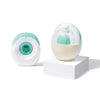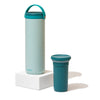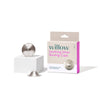The early days of breastfeeding are all about establishing your milk supply while ensuring your newborn’s nutritional needs are met. A healthy supply is critical for a successful feeding journey!
From the moment your baby arrives, there are a number of ways that you can begin to encourage milk production, such as doing skin-to-skin as much as possible and trying to feed on demand. Your body will catch on quickly — one of the marvels of breastfeeding is that your supply naturally adjusts to your infant’s demands. Your hormones are linked to your baby’s feeding times, hunger cues, and how much they suckle and feed.
In this article, we’ll dive deep into all things supply and how to optimize it, starting with how it works in the first place. We’ll cover:
- What “supply and demand” really means
- Factors that influence milk production
- How to increase supply with a pump
- How to increase supply through diet, stress reduction, and supplements
- And more!
How Breast Milk Supply Works
During pregnancy, your hormones stimulate the production of colostrum. You’ll produce this thick yellow milk during your baby’s first two to four days, although some moms can even collect it in their final trimester! Because it contains important white blood cells, antibodies, and proteins, it can help build your baby’s immune system against potential infections — and is why it has earned the nickname “liquid gold.”
About three to five days after delivery, your mammary glands begin producing thinner milk that appears whiter, bluer, or grayer, though some colostrum will remain for up to six more weeks. At about two weeks postpartum, this “transitional” milk becomes “mature” with all the fat and nutrients your baby needs for the first six months of their life. (This is why babies don’t need any solid food during this time!)
When your baby cries out of hunger, your brain releases oxytocin, also known as the letdown hormone — and when they begin suckling, this oxytocin tells your milk to start flowing. As milk is removed from your breast, your body is cued to produce more — replacing what your baby has just consumed. This is what people often refer to as “supply and demand.”
Because your newborn’s stomach grows from roughly the size of a cherry at birth to the size of an egg at four weeks, they can only take in so much milk at a given time. This is why they need to eat so often! In these early days, a good goal is 8-12 feeds throughout a 24-hour period, which means about every 2-3 hours — this will help you ensure that they’re getting what they need and give you the best chance at maintaining your production.
Beyond feeding “on demand,” other factors — from diet and hydration to the amount of rest you get — will impact your ability to produce the most milk. It’s simple: if you’re not getting enough rest, drinking enough water, or consuming enough nutrient-dense food, your milk supply will likely take a dip.
Effective Ways to Boost Your Milk Supply
We know that this can be a stressful and sleep-deprived time, so we’re here to reassure you that it’s possible to boost your supply and give your baby what they need.
Frequent Breastfeeding or Pumping
Remember: the more often you empty your breasts, the more milk you will likely make. This isn’t the time to focus on a strict “schedule” — that can come later after you’ve gotten into a good groove with your baby and are confident that your supply is in a good place. If you have a sleepy baby, placing them skin-to-skin can help them wake up for a feeding!
Pumping can also be helpful when you’re looking to boost your production. While pediatricians and lactation consultants often recommend that you wait 4-6 weeks (or until you’ve established a breastfeeding routine) before introducing a pump, there are definitely exceptions to this rule — and needing to increase your supply is one of them!
You can try pumping directly after a nursing session for about 10-15 minutes or until your breasts feel emptied. The goal is to remove as much milk as possible, signaling your body to produce more milk. (Note: beyond the postpartum period, this is something you can do at any point during your breastfeeding journey to boost your supply!)
Throughout the day, you can also try “power pumping” — pumping for short periods of time in back-to-back sessions and mimicking your baby’s cluster feeds. This might look like:
- Pumping for 20 minutes
- Resting for 10 minutes
- Pumping for 10 minutes
- Resting for 10 minutes
- Pumping for 10 final minutes
Since this can be a lot — physically and emotionally — you’ll want to limit this to a few days. “Think of this as a temporary stopgap measure to get your supply and/or your baby's weight to a healthy, workable level,” says Dr. Laurie Jones, a pediatrician and founder of Dr. MILK (Mothers Interested in Lactation Knowledge). “It’s not tenable to do this around the clock, or for long periods of time.”
Staying Hydrated
One of the best things you can do to support your breast milk supply is stay hydrated. Breast milk is composed of about 88% water, so it’s critical that you replenish what your body is sharing with your baby by drinking more than you normally would!
This is especially important when the weather gets warmer (since you’re likely to sweat more) and even more important if you’re someone who walks a lot or exercises outdoors.
While your hydration needs will vary based on how humid your surroundings are, how high the temperature gets, and how active you are, there are a few rules of thumb:
- You should drink enough so that you’re not feeling thirsty (if you’re thirsty, you’re already a little bit dehydrated!)
- Aim to drink a cup of water during every feeding or pumping session (this is especially doable if you’re using a hands-free pump!)
- Your urine should be light in color, as this is an indicator of proper hydration (anything that’s dark or bright yellow means you’re not getting enough!)
- If you're getting enough liquids, you should go to the bathroom about every 90 minutes (more than that is fine!).
And remember: while you’re probably in need of a coffee (or three of them!), caffeine is a diuretic. You’ll want to make sure that you consume it in moderation.
A few other pointers:
- Drinking too much water before bed will likely disrupt your sleep, so try to load up on water (fill those reserves!) earlier in the day
- Try to avoid sugary drinks since sugar can reduce the amount of fluid that your body retains. Instead, opt for a low or sugar-free mocktail to stay hydrated while breastfeeding.
- It is possible to be overhydrated, which can have a negative impact on your supply as your body works to restore its electrolyte balance
Eating a Balanced Diet
First things first, you’ll need to make sure that you’re getting adequate calories to maintain a healthy supply. Your baby is getting all the nutrients they need to grow from you — and in turn, you’ll need to eat more to get all the nutrients you need!
According to Dr. Manisha Panchal, breastfeeding moms require approximately 400 more calories per day than non-lactating mothers. (If you’re a mom of twins, double that. If you’re a mom of triplets, triple that!). For women consuming a well-balanced diet, the increased nutrient requirements can usually be met by the overall increase in food intake. (Beyond calories, breastfeeding also increases moms’ need for protein; vitamins A, C, E, B6, and B12; folate; niacin; riboflavin; thiamine; and the minerals iodine, selenium, and zinc!)
Here are some foods to focus on:
- Calcium: milk, cheese, yogurt, tofu; bok choy, broccoli, kale, collard, mustard, and turnip greens.
- Zinc: meat, poultry, seafood, eggs, seeds, legumes, yogurt, whole grains
- Magnesium: nuts, seeds, legumes, whole grains, green vegetables, scallops, and oysters
- Vitamin B6: bananas, poultry, meat, fish, potatoes, sweet potatoes, spinach, prunes, watermelon, some legumes, fortified cereals, and nuts
- Thiamine: pork, fish, whole grains, organ meats, legumes, corn, peas, seeds, nuts, fortified cereal grain
- Folate: leafy vegetables, fruit, liver, green beans, fortified cereals, legumes, and whole-grain cereals.
- DHA and EPA (fish): canned light tuna, salmon, pollock, catfish, and shrimp (try to avoid fish that are high in mercury such as pike, marlin, mackerel, tilefish, swordfish)
- DHA and EPA (vegetarian): algal or soybean oil, walnuts, chia, hemp, and flax seeds
There are 23 foods that are thought to play a role in boosting supply. These include oats, fennel and fennel seed, sesame seeds, green papaya, chickpeas and lentils, brewer’s yeast or nutritional yeast, and dark leafy greens. You may also come across herbal galactagogues, like fenugreek and blessed thistle, in capsules or teas. Again, you’ll want to consult with your healthcare provider or a lactation consultant before incorporating any of these into your routine — like any supplement or medication, they can come with adverse side effects.
In summary, here’s what you’ll want to try and remember about nutrition:
- Increase the amount of food you eat by approximately 400 kcal per day (this will reduce after your baby starts eating solids)
- Include protein foods 2-3 times per day (meat, poultry, fish, eggs, dairy, beans, nuts, and seeds.)
- Eat three servings of vegetables, including dark green and yellow vegetables per day.
- Eat two servings of fruit per day.
- Include whole grains daily (whole wheat bread, pasta, cereal, and oatmeal.)
- If you avoid meat, make sure you eat other sources of iron and zinc, such as dried beans, dried fruit, nuts, seeds, and dairy. If you avoid all animal products (vegan diet), you will need to take a B12 supplement to ensure your baby does not develop a B12 deficiency.
Getting Enough Rest
There’s no way around it: when you’re focused on a newborn, getting adequate sleep isn’t always easy. New moms are tired.
This sleep deprivation can take a toll on many things, from your mental health to your milk supply. Sleep deprivation is linked with stress, and stress is linked with the release of cortisol — a hormone that can slow down your flow of breast milk. Stress can also impair oxytocin, a hormone that helps to encourage letdowns.
So what can you do to try and get more shut eye and maintain a healthy supply as a new parent?
First up, nap! Napping is so important that Dr. Laurie Jones writes new moms “prescriptions” for two 20 - 40-minute daytime naps daily. “As long as you’re in a dark, quiet room, and you’re lying down, your cortisol levels and heart rate come down, your breathing slows, and your metabolic rate goes down—even if you don't sleep,” she says.
To give yourself the best chance at rejuvenation, turn off the light and close the blinds. Keep things that might help you fall asleep, such as an eye mask, white-noise machine, or a book handy. Also, try to limit the use of screens. Not only can your engagement with the digital realm be stimulating, but the blue light they emit suppresses the sleep hormone melatonin, making it more difficult to rest.
Second, practice good “sleep hygiene” to give yourself the best shot at restful nighttime sleep. Funny enough, this starts in the morning: exposure to daylight is important for setting your circadian rhythms. Daylight is energizing, and the earlier you’re exposed to it, the better, says Chris Raines, a perinatal psychiatric nurse practitioner. Open your blinds or curtains as soon as you wake up, and if you can, take a stroll (solo or with your baby) outdoors.
You should also try to set consistent sleep and wake times — we know, easier said than done! Research from the Cleveland Clinic says going to bed and waking up for the day at consistent times helps set and maintain your circadian rhythms. Such habits go a long way toward regulating your sleep cycle.
Breast Massage
Breast massage can help encourage production by stimulating blood flow and directing milk flow towards the nipples. It’s especially helpful before a pumping or feeding session and can be done by hand or with a lactation massager like the LaVie Warming Lactation Massager. Just remember not to pinch, pull, or push on your skin too vigorously, as this might actually have an adverse effect!
If you’re massaging your breasts by hand, press your pointer finger and middle finger firmly together. Then, beginning at the top of your chest wall, move your fingers down towards your nipple, stopping before you reach the areola. It may be helpful to use your other hand to lightly hold your breast, giving you more leverage.
Breast massage (along with hot showers) can also help prevent and/or relieve some of the breast conditions — including engorgement, plugged ducts, and mastitis — that can make it hard to feed. If you’re dealing with one of these conditions, the key is to keep your milk flowing, even if it’s a little bit uncomfortable at first, so that you don’t end up with an even bigger issue that causes your supply to take a dip.
Lifestyle Changes to Boost Milk Production
Beyond focusing on your sleep, there are many other ways to manage stress and give yourself the best chance at optimal milk production.
Getting in the habit of grounding yourself when you’re feeling anxious — whether through a 10-minute meditation, stretching, rolling out your yoga mat, or simply taking a few deep breaths — can help lower your cortisol levels before a feeding session.
You can also try and create a relaxing environment when nursing or pumping by lowering the lights, lighting a candle, turning on a calming playlist, or having a favorite cup of tea within reach. These are little things that make a huge difference when you’re feeling tired, anxious, or overwhelmed — emotions that are so common during the postpartum period.
Avoiding Smoking and Alcohol
Alcohol and nicotine can pass into your bloodstream, posing a potential risk to your baby’s growth and development and impacting your milk production as well.
Specifically, these substances can interfere with your letdown. How? Alcohol can reduce oxytocin levels while increasing prolactin levels and both hormones influence the milk ejection reflex. The lower the level of oxytocin, the longer the delay in the ejection of milk. The higher the level of prolactin, the longer the delay. The combination of alcohol’s effect on the two hormones leads to a significant delay in milk ejection. (La Leche League International)
Tracking Your Milk Supply Progress
To monitor your milk production and stay on top of any dips in your supply, use a journal to record the length of your nursing sessions or your output in ounces (if pumping). Many apps make this information easy to organize — and if you’re pumping with Willow, you can use the Willow app to view a daily log of your sessions and your history over time.
Of course, you don’t need a journal or app to see that your supply has improved — a baby that is gaining weight and increasing the number of wet diapers they produce is the best indicator of increased production.
Pumping 101: How to Pick a Breast Pump
Looking to Optimize Your Milk Supply?
In this article, we discussed several ways to increase milk production, from feeding on demand and staying hydrated to optimizing your nutrition, reducing stress, and creating a calm feeding environment. Unfortunately, there’s no magic wand or one-size-fits-all approach to making more milk — but with the tips we’ve shared, you’re on your way to making your most milk.
Remember that lactation consultants can be an extremely helpful and game-changing resource when you’re unsure if your baby is getting enough milk and don’t know where to start. Start by asking your pediatrician or OBGYN for a local recommendation, or explore care through a platform like SimpliFed, which offers virtual support.
Finally, remember that most moms are making enough milk for their babies, even if they don’t feel like they’re producing a lot. (Read that sentence again!) Even more importantly, breastfeeding is not all or nothing. Any amount you can do carries benefits for both you and your baby, and the benefits of breastfeeding increase based on its duration — so smaller amounts for longer are preferred to exclusive breastfeeding for shorter. The good news is you can get those benefits even if you don’t exclusively breastfeed!
You can learn more about supply and find tips for pumping to increase milk production here.
Increasing Milk Supply FAQs
- How can I increase my milk supply when pumping?
- To increase your milk supply when pumping, pump frequently, especially right after nursing sessions, and stay well-hydrated by drinking plenty of water. Eating a balanced diet rich in nutrients, and gently massaging your breasts before and during pumping sessions can also help stimulate milk production.
- What factors influence breast milk production?
- Several factors influence breast milk production, including the frequency of feeding or pumping, proper hydration, and a nutrient-rich diet. Additionally, adequate rest, managing stress levels, and avoiding substances like alcohol and nicotine are crucial for maintaining a healthy milk supply.
- How does the “supply and demand” principle work in breastfeeding?
- The "supply and demand" principle in breastfeeding means that your body produces more milk as your baby feeds more frequently. Regularly emptying your breasts through nursing or pumping signals your body to produce more milk, ensuring that your supply matches your baby's growing needs.
Tags Used





